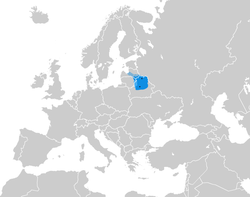Principality of Polotsk
This article needs additional citations for verification. (June 2023) |
Principality of Polotsk Полотєскаѧ Княжество (Old East Slavic) | |||||||||
|---|---|---|---|---|---|---|---|---|---|
| 987–1504 | |||||||||
Banner of Polotesk under the Lithuanian domain.
| |||||||||
 The Principality of Polotsk on the map of Europe | |||||||||
| Status |
| ||||||||
| Capital | Polotesk | ||||||||
| Common languages | Old East Slavic | ||||||||
| Religion | Eastern Orthodoxy Slavic paganism | ||||||||
| Government | Monarchy | ||||||||
| Prince of Polotsk | |||||||||
• 1044–1101 | Vseslav | ||||||||
| Legislature | Veche | ||||||||
| History | |||||||||
• Established | 987 | ||||||||
• Total incorporation into the Grand Duchy of Lithuania | 1504 | ||||||||
| |||||||||
| Today part of | Belarus Latvia Russia | ||||||||
The Principality of Polotsk (
The principality was supposedly established around the town of Polotsk (now in Belarus) by the tribal union of Krivichs. In the second half of the 10th century, Polotsk was governed by its own dynasty; its first ruler mentioned in the chronicles was the semi-legendary Rogvolod (?–978), better known as the father of Rogneda. The principality was heavily involved in several succession crises of the 11th–12th centuries and a war with the Land of Novgorod. By the 13th century, it was integrated into the Grand Duchy of Lithuania.
At the time of its greatest extent, the principality stretched over large parts of present-day northern and central Belarus and a smaller part of today's southeastern Latvia, including (besides Polotsk itself) the following towns: Vitebsk, Drutsk, Minsk, Izjaslaw (now Zaslawye), Lahoysk, Barysaw, Brachyslaw (now Braslaw), Kukeinos (now Koknese) and others.
History
Origins
There is no exact date on record when the principality was formed; it was likely an evolutionary process. In 862
The second time Polotsk was mentioned was a full century later, in 980 when its ruler was a
In 972, after the prince of
After Vladimir converted to Christianity in 988 and took
Striving for independence
In 1001 Izyaslav was succeeded by his son,
For two following centuries, the Principality of Polotsk was controlled by descendants of Izyaslav. All other lands of Kievan Rus' were under the control of princes who were descendants of Yaroslav the Wise.
The golden age of medieval Polotsk is associated with the rule of Bryachislav's son,
The
Decline
After his defeat at the
Beginning in the mid-12th century there were changes in the lands to the west of the Principality. The fortress of Riga became the main military basis of the Livonian Brothers of the Sword. In 1209 German crusaders conquered the principalities of Jersika and Koknese in the southeast of today's Latvia, which had previously been under the control of Polotsk, forcing Polotsk to permit free travel to German merchants in 1212 and ending Livonian tributes. In 1227 Smolensk ceded Polotsk by treaty to the city of Riga.
Annals affirming the alliance and united military campaigns policy of Polotsk and Lithuania. For example, The Chronicle of Novgorod informs about "Izyaslav had been set to be Knyaz in Luki and covered Novgorod from the Lithuanians" in 1198 while Luki is situated on the east of Polotsk. [4]
The Principality of Polotsk escaped the
Gallery
| History of Belarus |
|---|
| Prehistory |
| Middle ages |
|
Early Modern |
|
| Modern |
|
|
|
-
Polotsk within Kievan Rus' c. 1100
-
Principality of Polotsk (1132)
-
Polotsk in the 12th century
-
Polocensis Ducatus on a 1596 map by Mercator
-
Coat of arms of Lithuania's Połock and Witebsk Voivodships
See also
References
- ^ Linda Gordon (1983): Cossack Rebellions: Social Turmoil in the Sixteenth Century Ukraine (p. 241)
- ISBN 978-1-317-87314-3. Retrieved 14 September 2018.
- ISBN 9789004352148.
- ^ Michell, Robert; Shakhmaton, A.A; Forbes, Nevill; Beazley, C. Raymond (Charles Raymond) (1914). The chronicle of Novgorod, 1016–1471. London, Offices of the society. pp. 41.







